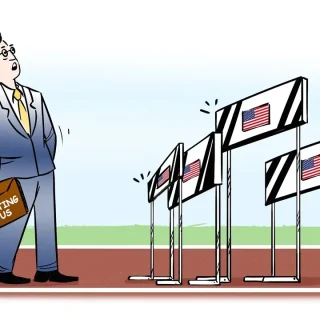Safeguarding Wealth: How Investment Migration Shields You from Currency Depreciation and Inflation Risk
The global economy in 2025 is characterized by a delicate balance between growth and uncertainty. While the International Monetary Fund (IMF) projects a global growth rate of 3.3% for 2025 and 2026, this optimism is tempered by potential challenges such as trade tensions, geopolitical shifts, and fluctuating commodity prices. These factors contribute to an unpredictable economic environment, prompting investors to seek strategies that safeguard their assets against unforeseen downturns.
The Critical Nature of Currency Depreciation Risk

Savings Deterioration
When a country’s currency loses value, the money people have saved becomes worth less over time. This means that even if someone has a large amount of savings, their purchasing power declines because prices for goods and services rise while their currency weakens.
For example, in Argentina, inflation is projected to hit 54% in 2025. This means that if someone had $10,000 in Argentine pesos saved at the beginning of the year, by the end of the year, those same savings would only buy what $4,600 could have purchased before. Everyday essentials like food, housing, and healthcare become significantly more expensive, making it difficult for individuals to maintain their financial stability.
This is why many investors and high-net-worth individuals move their wealth into stronger currencies or stable economies—to protect their savings from being eroded by inflation and currency depreciation.
Investment Return Distortion
When a currency depreciates, investment returns can shrink once adjusted for exchange rates. Even if an investment performs well in local currency, its real value may decline when converted to a stronger currency.
For example, an investor in Turkey earns 15% on real estate, but if the Turkish lira depreciates by 25% against the US dollar, their gains are wiped out when converted. Instead of making a profit, they suffer a loss in real terms.
This risk discourages foreign investment and affects portfolio growth. To protect returns, investors often diversify into stable economies or hedge against currency fluctuations.
Primary Drivers of Currency Risk
Macroeconomic Factors: Elements such as inflation rates, fiscal deficits, and central bank policies play pivotal roles in determining a currency’s strength. For example, countries with high inflation and substantial fiscal deficits often experience currency depreciation as confidence in the currency wanes. Conversely, prudent fiscal management and stable monetary policies can bolster currency value.
Political Instability: Political events, including sanctions, trade wars, and governance issues, can precipitate rapid currency fluctuations. The uncertainty stemming from such events can lead to reduced foreign investment and capital flight, further exacerbating currency depreciation. For instance, ongoing trade tensions have been identified as substantial risks to both domestic and global economic stability.
Market Dynamics: Investor sentiment, capital flows, and foreign exchange reserves significantly influence currency values. A loss of investor confidence can trigger capital flight, leading to a sharp decline in currency value. Monitoring these dynamics is crucial for anticipating and mitigating currency risk.
Market Response Patterns
In response to currency depreciation, global investors often seek refuge in more stable assets or currencies. This flight to safety can involve reallocating investments to economies with stronger currencies or more stable political environments. For example, the U.S. dollar has traditionally been viewed as a safe-haven currency during periods of global economic uncertainty.
Investment Migration as a Strategic Hedge Against Economic Uncertainty

Diversifying Financial Exposure
Acquiring a second residency allows investors to diversify their financial exposure across different economic systems and currencies. This strategy mitigates the risk associated with any single country’s economic downturn or currency depreciation. By holding assets in multiple jurisdictions, investors can better protect their wealth from localized economic shocks.
Access to Foreign Banking and Investment Opportunities
Second residency often grants access to international banking systems and investment opportunities that may not be available domestically. This access enables investors to diversify their portfolios globally, reducing the impact of domestic economic volatility. For instance, residency in financial hubs like Singapore or Switzerland can provide avenues for more secure and diverse investment options.
Examples of Residency Programs Popular Among Investors Hedging Currency Risk
Several residency programs have gained popularity among investors seeking to hedge against currency risk:
- Malta’s Residency and Visa Program: Grants residency through contributions and investments, appealing due to Malta’s robust financial sector.
- Singapore Global Investor Program: Provides residency to investors who establish businesses or invest substantially, offering a foothold in Asia’s growing markets.
- United Arab Emirates Golden Visa: Offers long-term residency to investors, entrepreneurs, and skilled professionals, providing tax advantages and a stable financial environment in the Middle East.
- Canada’s Start-Up Visa Program: Grants permanent residency to entrepreneurs who create innovative businesses with job creation potential, offering access to a stable economy and strong banking system.
These programs exemplify how strategic investment migration can serve as a hedge against economic uncertainties, including currency depreciation and inflation.
In an interconnected and often unpredictable global economy, safeguarding wealth requires proactive and strategic measures. Understanding the multifaceted nature of currency depreciation and its drivers is crucial for investors aiming to protect their assets. Investment migration, through the acquisition of second residencies, emerges as a viable strategy to mitigate these risks. By diversifying financial exposure, accessing stable banking systems, and participating in robust investment opportunities, investors can effectively hedge against the adverse effects of currency depreciation and inflation. As economic landscapes continue to evolve, such strategies will remain integral to prudent wealth management.










